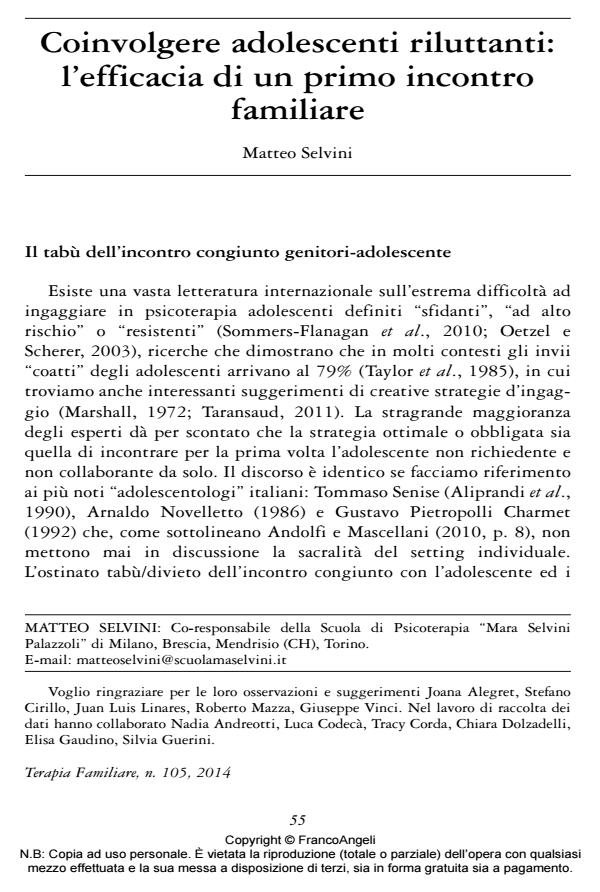Coinvolgere adolescenti riluttanti: l’efficacia di un primo incontro familiare
Journal title TERAPIA FAMILIARE
Author/s Matteo Selvini
Publishing Year 2014 Issue 2014/105 Language Italian
Pages 21 P. 55-75 File size 102 KB
DOI 10.3280/TF2014-105003
DOI is like a bar code for intellectual property: to have more infomation
click here
Below, you can see the article first page
If you want to buy this article in PDF format, you can do it, following the instructions to buy download credits

FrancoAngeli is member of Publishers International Linking Association, Inc (PILA), a not-for-profit association which run the CrossRef service enabling links to and from online scholarly content.
Following a research on 179 cases assessed in the last 8 years the author discusses the efficacy of an introductory familiar meeting in order to involve into treatment non requiring teen agers, which means nearly all the teen agers that come in contact with a psychotherapist. After describing nine kinds of non- cooperative teen agers and two cooperative ones, the guidelines and the taking charge techniques are dealt with, from the first contact to the first/second family meeting: safety of the meeting, emotional implications, authority of the therapist, psychological explanations, sharing of personal stories, rebuilding of membership.
Keywords: Forced charge, to oppose the parents’ delegation, safety area, to accompany the teen ager, to invent a new definition of the problem.
- Aliprandi M.T. et al. (1990). Psicoterapia breve di individuazione. Milano: Feltrinelli.
- Aliprandi M.T., Pelanda E., Senise T. (1990). Psicoterapia breve d’individuazione. La metodologia di Tommaso Senise nella consultazione con un adolescente. Milano: Feltrinelli.
- Andolfi, M., Mascellani, A. (2010). Storie di adolescenza. Milano: Raffaello Cortina.
- Andolfi M., Angelo C., D’Atena M. (2001). La terapia narrata dalle famiglie. Milano: Raffaello Cortina.
- Baldascini L. (1993). Vita da adolescenti. Milano: FrancoAngeli.
- Boss P. (1999). Ambiguity Loss. Learning to live with unrisolved grief. Cambridge, MA: Harvard University Press.
- Cancrini L., Vinci G. (2013). Conversazioni sulla psicoterapia. Roma: Alpes Italia.
- Cirillo S., Mazza R. et al. (1996). La famiglia del tossicodipendente. Milano: Raffaello Cortina.
- Escudero V., Muniz de la Pena C. (2010). Adolescentes y familias en conflicto: un modelo de intervención focalizada en la alianza terapéutica. Sistemas Familiares,
- 1: 61-91. Friedlander M., Escudero V., Heatherington L. (2006). Alleanze terapeutiche nella terapia di coppia e della famiglia (trad. it.: Roma: Firera e Liuzzo, 2011).
- Higham J.E., Friedlander M., Escudero V., Diamond C. (2012). Engaging reluctant adolescents in family therapy: an exploratory study of in-session processes of change. J. Fam. Th., 34 (1): 24-52. DOI: 10.1111/j.1467-6427.2011.00571.
- Liddle H.A. (1995). Conceptual clinical dimensions of multidimensional multisystems engagement strategy in family based adolescent treatment. Psychotherapy, 32: 39-58.
- Keating V., Cosgrave E. (2006). The first ten minutes: clinicians perspectives on engaging adolescents in therapy. Australian Journal of Guidance and Counselling, 16, 2: 141-14-7.
- DOI: 10.1017/s0022377807006861MariottiM.,FrisonR.(2000).Relazioniterapeuticheeadolescentimultiproblematici.Milano:FrancoAngeli
- Marshall R. (1972). The treatment of resistences in psychotherapy of children and adolescents. Psychotherapy: Theory Research and Practice, 9, 2: 143-148.
- National Institute for Health and Care Excellence (2013). Antisocial behaviour and conduct disorders in children and young people: recognition, intervention and management. Nice clinical guide, 158.
- Oetzel K.B., Scherer D.G. (2003). Therapeutic engagement with adolescents in Psychotherapy. Psychotherapy: Theory Research and Practice, 40, 3: 215-225.
- Pietropolli Charmet G., Rosci E. (1992). La seconda nascita. Milano: Unicopli.
- Romano E. (2012). L’adolescenza in attesa. In: Onnis L. (a cura di), La terapia familiare. Milano: Franco Angeli.
- Rubenstein A.K. (2005). Methods to engage the reluctant adolescent. In: Koocher
- G.P.H., Norcross J.C., Hill S.S. (eds.), Psychologists’ desk reference (2nd edn). New York: Oxford University, pp. 1169-1175.
- Selvini M. (2003). Tecniche di presa in carico psicoterapeutica di un paziente non richiedente. Terapia Familiare, 73: 5-33.
- Selvini M. (2008). Undici tipi di personalità. L’integrazione della diagnosi di personalità nel pensiero sistemico complesso. Ecologia della Mente, 31: 29-56.
- Selvini M. (2010). Un terapeuta sistemico cacciatore e allevatore. Psicobiettivo, XXX. DOI: 10.3280/PSOB2010-00100
- Selvini M. (2014). L’integrazione della diagnosi di personalità e dei funzionamenti post-traumatici nel pensiero sistemico. Ecologia della Mente, 37, 1: 49-59. DOI: 10.1712/1507.1655
- Selvini M., Sorrentino A.M., Gritti M.C. (2012). Promuovere la resilienza “individuale-sistemica”: un modello a sei fasi. Psicobiettivo, XXXII. DOI: 10.3280/PSOB2012-00300
- Selvini Palazzoli M. et al. (1973). Il trattamento dei bambini attraverso la terapia breve dei genitori. Ripubblicato in Selvini M. (2004). Reinventare la psicoterapia. Milano: Raffello Cortina.
- Selvini Palazzoli M. et al. (1998). Ragazze anoressiche e bulimiche. Milano: Raffaello Cortina.
- Sommers-Flanagan J., Richardson B.G., Sommers-Flanagan R. (2010). A multitheoretical, evidence-based approach for understanding and managing adolescent resistance to psychotherapy. J. Contemp. Psychother., 41: 69-80.
- Taransaud D. (2011). You think I’m evil. London: Worth Publishing. Taylor L., Adelman H.S., Kaser-Boyd N. (1985). Exploring Minors’ reluctance and dissatisfaction with psychotherapy. Professional Psychology: research and practise, 16, 3: 418-425.
- Tharinger D.J., Gentry L.B., Finn S.E. (2013). Therapeutic assessment with adolescents and their parents. In: Sakllofske D., Schwean V. (eds.) (in press), Oxford Handbook of Psychological Assessment of Children and Adolescent. New York: Oxford University Press.
- Verso un modello evolutivo individuale/sistemico dei disturbi della personalità Matteo Selvini, in PSICOBIETTIVO 2/2014 pp.46
DOI: 10.3280/PSOB2014-002004 - Le ragioni di una terapia con i soli genitori quando la domanda riguarda i figli Flavio Ravasio, in TERAPIA FAMILIARE 115/2017 pp.9
DOI: 10.3280/TF2017-115002 - Clinical Interventions in Systemic Couple and Family Therapy Matteo Selvini, pp.63 (ISBN:978-3-319-78520-2)
Matteo Selvini, Coinvolgere adolescenti riluttanti: l’efficacia di un primo incontro familiare in "TERAPIA FAMILIARE" 105/2014, pp 55-75, DOI: 10.3280/TF2014-105003